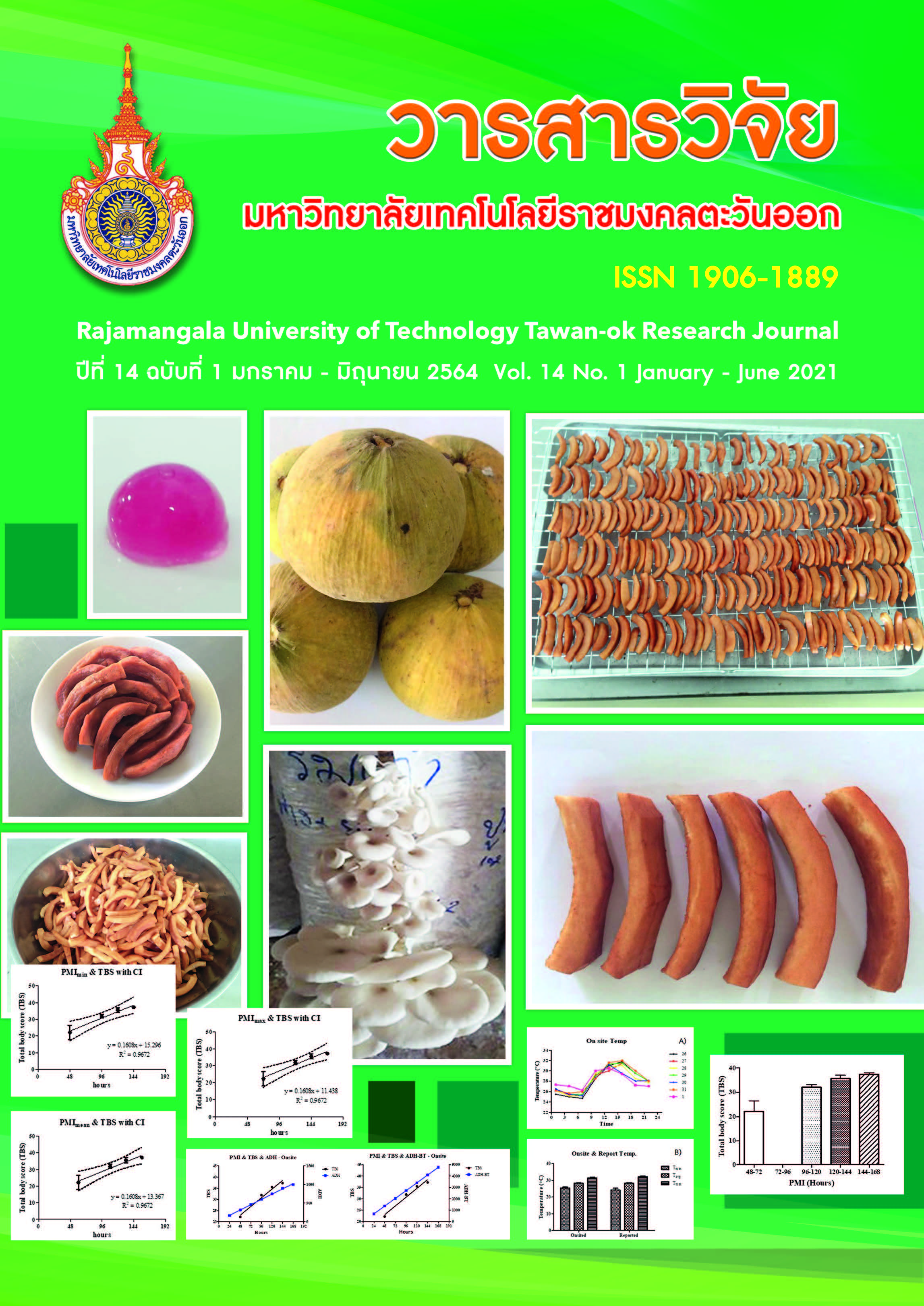รูปแบบสมการสำหรับการประเมินช่วงหลังการเสียชีวิตจากการเปลี่ยนแปลงอุณหภูมิ แวดล้อมต่อคะแนนการเปลี่ยนแปลงร่างกายรวมและระยะเวลาการเสียชีวิตของศพ
Main Article Content
บทคัดย่อ
ปัจจัยอุณหภูมิแวดล้อมส่งผลต่อลักษณะการเปลี่ยนแปลงหลังการตายของศพ แพทย์นิติเวชทำการประเมินเวลาตายได้โดยการตรวจการเปลี่ยนแปลงภายหลังตายที่เกิดกับศพเป็นหลัก งานวิจัยนี้มีวัตถุประสงค์เพื่อหาความสัมพันธ์การเปลี่ยนแปลงอุณหภูมิสะสมต่อคะแนนร่างกายรวมและเวลาการเสียชีวิตของศพ สำหรับใช้เป็นรูปแบบการประเมินเวลาการเสียชีวิตในประเทศไทยภูมิภาคเขตร้อนชื้น งานวิจัยนี้เป็นงานวิจัยเชิงคุณภาพและเชิงเอกสารจากข้อมูลทุติยภูมิ (secondary data) ศึกษาความสัมพันธ์ของอุณหภูมิสะสมต่อการเปลี่ยนแปลงคะแนนร่างกายรวมของศพกับเวลาการเสียชีวิต ซึ่งคิดจากคะแนนการเปลี่ยนแปลงร่างกายรวมทั้งสิ้น 48 คะแนน ผลการ ศึกษาเวลาการเสียชีวิตขอบต่ำ กลาง สูง ของช่วงเวลาการเสียชีวิตกลุ่มต่าง ๆ กับคะแนนร่างกายรวม พร้อมกับช่วง 95% confident interval พบว่า ที่เวลาการเสียชีวิตช่วงต่ำได้สมการเชิงเส้นและสัมประสิทธิ์การกำหนด (95% CI) คือ y = 0.1608x + 15.296, R2= 0.9672 (5.575-25.02) เวลาการเสียชีวิตช่วงกลางได้สมการเชิงเส้นและสัมประสิทธิ์การกำหนด (95% CI) คือ y = 0.1608x + 13.367, R2 = 0.9672 (2.620-24.11) และเวลาการเสียชีวิตช่วงสูงได้สมการเชิงเส้นและสัมประสิทธิ์การกำหนด (95% CI) คือ y = 0.1608x + 13.367, R2 = 0.9672 (2.620-24.11) ตามเกณฑ์การประเมินคะแนนการเปลี่ยนแปลงร่างกายหลังเสียชีวิตในศพลักษณะสดมีคะแนนขั้นต่ำสุด คือ 8 คะแนน เมื่อนำมาใช้กับสมการจะได้เวลาการเสียชีวิตต่ำสุดเป็น 4.72 ชั่วโมง สมการเชิงเส้นและสัมประสิทธิ์การกำหนดของคะแนนร่างกายรวมของการเปลี่ยนแปลงตามระยะเวลาหลังเสียชีวิต (PMI) อุณหภูมิสะสมรายวันของพื้นที่เกิดเหตุและกรมอุตุนิยมวิทยาไม่มีความแตกต่างกันทั้งเส้นความชัน (Slope) จุดตัดแกน y และสัมประสิทธิ์การกำหนด (coefficient of determination)
Article Details
References
Amendt, J., C. P. Campobasso, E. Gaudry, C. Reiter, H.N. LeBlanc and M.J.R. Hall. 2007. Best practice
in forensic entomology-standards and guidelines. Int J Legal Med. 121(2): 90-104.
Bass, W.M. 1997. Outdoor decomposition rates in Tennessee [in] forensic taphonomy: the postmortem fate of human remains in forensic taphonomy: the postmortem fate of human remains. CRC Press, Boca Raton, Florida.
Brown, C. and T. Peckmann. 2013. Decomposition rates and taphonomic changes associated with the estimation of time since death in a summer climate: a case study from urban Nova Scotia. Can Soc Forensic Sci. 46(4): 209-230.
Chockjamsai, M. 1999. Death and postmortem transformation. Department of Forensic Medicine, Faculty of Medicine, Chiang Mai, Chiang Mai. (in Thai)
Clark, M., M. Worrell and J. Pless. 1997. Postmortem Changes in soft tissues. In: Forensic taphonomy the postmortem fate of human remains. CRC Press, Boca Raton, Florida.
DiMaio, V. and D. DiMaio. 2001. Forensic Pathology. (Second edition ed.). CRC Press, Boca Raton, Florida.
Forbes, S. 2004. Time since death: a novel approach to dating skeletal remains. Aust J Forensic Sci. 36(2), 67-72.
Forbes, S. and K. Nugent. 2009. Dating of Anthropological Skeletal Remains of Forensic Interest in Handbook of Forensic Anthropology and Archaeology. Left Coast Press, Inc. Walnut Creek, California.
Galloway, A. 1997. The process of decomposition: a model from the Arizona-Sonoran desert. In: Forensic taphonomy the postmortem fate of human remains. The United States of America: CRC Press, Boca Raton, Florida.
Gruenthal, A. C. Moffatt and T. Simmons. 2012. Differential decomposition patterns in charred versus uncharred remains. J Forensic Sci. 57(1): 12-18.
Heaton, V. A. Lagden, C. Moffatt and T. Simmons. 2010. Predicting the postmortem submersion interval for human remains recovered from UK waterways. J Forensic Sci. 55(2): 301-307.
Klepinger, L.L. 2006. The Postmortem Period in Fundamentals of Forensic Anthropology. John Wiley and Sons, Inc. Koboken, New Jersey.
Mann, R., W. Bass and L. Meadows. 1990. Time since death and decomposition of the human body: variables and observations in case and experimental field studies. J Forensic Sci. 35(1): 103-111.
Marhoff, S.J. 2013. Using accumulated degree days and a degree of decomposition index to estimate the post-mortem interval of decomposing remains found in the Hawkesbury region: a porcine model (unpublished Honours thesis), in school of science and health. University of Western Sydney: Campbelltown Campus.
Megyesi, M.S. S.P. Nawrocki and N.H. Haskell. 2005. Using accumulated degree-days to estimate the
postmortem interval from decomposed human remains. J Forensic Sci. 50(3): 618-626.
Melina, L. 2010. Physical and chemical analysis of pig carcass decomposition in a fine sand. [unpublished Master’s thesis on the internet]. Ontario, Canada: University of Ontario Institute of Technology, Retrieved from http://hdl.handle.net/10155/115
Moffatt, C. T. Simmons and J. Lynch-Aird. 2016. An improved equation for TBS and ADD: establishing a reliable postmortem interval framework for casework and experimental studies. J Forensic Sci. 61(S1): S201-207.
Myburgh, J., E. L’Abbé and M. Steyn. 2013. Estimating the post-mortem interval using accumulated degree-days in a South African setting. Forensic Sci Int. 229: 165e.161-166.
Parks, C. 2011. A study of the human decomposition sequence in Central Texas. J Forensic Sci. 56(1): 19-22.
Pickering, R.B. and D. Bachman. 2009. Determination of time since death, in the use of forensic anthropology. CRC Press Taylor and Francis Group: Boca Raton, Florida.
Rodriguez, W. and W. Bass. 1983. Insect activity and its relationship to decay rates of human cadavers in East Tennessee. J Forensic Sci. 28(2): 423-432.
Suckling, J.K., M.K. Spradley and K. Godde. 2016. A longitudinal study on human outdoor decomposition in Central Texas. J Forensic Sci. 61(1): 19-25.
Van Daalen, M.A., D.S. De Kat, B.F. Oude Grotebevelsborg, R. De Leeuwe, J. Warnaar, R.J. Oostra and
W.L.J.M. Duijst-Heesters. 2017. An aquatic decomposition scoring method to potentially predict the postmortem submersion interval of bodies recovered from the North sea. J Forensic Sci. 62(2): 369-373.
Wattanakhajorn, T. and U. Hunwijit. 1999. Death, change after death and estimating time of death. Bangkok: Chulalongkorn University Printing House. (in Thai)
Wilson-Taylor, R.J. and A.M. Dautartas. 2013. Time since death estimation and bone weathering, in Forensic Anthropology: An Introduction. CRC Press Taylor and Francis Group: Boca Raton, Florida.

